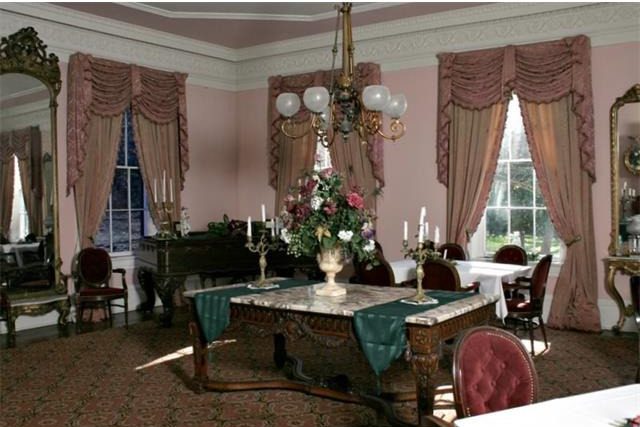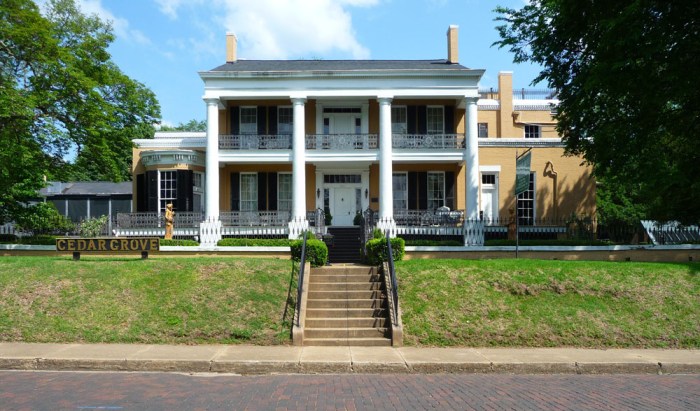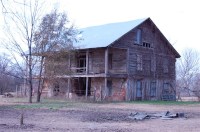Vicksburg’s famous Cedar Grove Inn overlooking the Mississippi River is on the market for $1.199 million dollars, offered by Ernesto Caldeira of Dorian Bennett Sotheby’s International Realty of New Orleans. You may recall that Mr. Caldeira is also a longtime Woodville preservationist and author of The Plantations of Wilkinson County in 2013.
According to the online listing:
This impressive Roman Revival masterpiece has been a landmark and for the last two decades has been one of Mississippi’s leading inns. It is a gourmet restaurant, an elegant and luxurious 33 room inn housed in several buildings, and it is a very popular venue for weddings, receptions, and meetings. Cedar Grove is offered turn-key fully furnished and equipped except for certain personal items.

As early as July 1936, Cedar Grove was recognized for its impressive architecture and gardens. Historic American Building Survey photographer James Butters took a couple of photos of Cedar Grove on his trip through Vicksburg that month, taking special care to include the cast iron gazebo in his frame.

FRONT (NORTHWEST ELEVATION) – John A. Klein House, 2200 Oak Street, Vicksburg, Warren County, MS. James Butters, HABS photographer, July 16, 1936. http://www.loc.gov/pictures/item/ms0142/
Cedar Grove was listed on the National Register of Historic Places in 1976. The MDAH Historic Resources Database describes it thus:
Built for John Alexander Klein beginning in 1840, Cedar Grove is a good example of Greek Revival domestic design. The house, located on a terrace overlooking the Mississippi River, is a five-bay, brick structure with three-bay porticoes on the east and west elevations. Its original four-over-four form was expanded with later side wings. Among its notable features is the original landscape design complete with terra cotta statuary, cast iron gazebo, brick walks, and fountains fed from an elevated cistern.
Klein’s 1884 obituary noted that he had “a great passion for building,” and Cedar Grove remains his master work. I’m sure he would be pleased with how it has been lovingly preserved for the community for all these years, and I hope someone will step up to move it into a new phase of life.

See other Mississippi historic places for sale:
Categories: Antebellum, For Sale, Vicksburg






Fingers crossed for a happy, wealthy, and preservation-sensitive new owner!
LikeLike
I pray someone who loves and values history will become the new steward for this beautiful piece of history!
LikeLike
If I could I would! This is a lovely treasure!
LikeLike
One thing I have not heard with any of these properties that have hit the market recently is whether any are protected from demolition, neglect, or insensitive development by preservation easements held by either a government agency or private organization.
Only Cedar Grove is located in a historic area of a city with local preservation ordinances to protect it (I have not looked to see if the house is located in one of Vicksburg’s local historic districts), though even those can be circumvented. The rest are either rural or outside of established historic districts. Everyone of them could be demolished tomorrow without any available course of action for preservationists to use to protect them. That is, of course, hyperbole. I doubt the next owner will demolish Cedar Grove or Waverley, though Starkville’s only antebellum houses are certainly threatened.
Yet, Waverley is on 34 acres near the Tombigbee River (not sure if it has any river frontage left or whether it is all owned by the Army Corps of Engineers). That type of property, near water, is very enticing to developers. One only needs to look at the development off Highway 50 north of Waverley to see that. On another level, Waverley has been perfectly “preserved” by the Snows more than it has been “restored.” The house has certainly been restored to make it a nice home, but it also has the genuine patina an old house will honestly accumulate with age. Will the next owner look at the original plaster walls, with their surface cracks and imperfections and say, “This house needs to be ‘restored.’ Let’s gut these walls to the studs and really ‘restore’ this house.” Will the next owner look at the woodwork and flooring say, “These floors could use a good sanding and restaining, and if all that trim is painted bright, flat white, it would really brighten the place up.” Perhaps, perhaps not.
The gut “restoration” is certainly en vogue now. One only needs to read the National Trust’s poorly, ignorantly, and superficially written posts (the ones not about booze or food) to see that, as they highlight “restoration” projects complete with, rife with new vinyl windows, exposed brick that was not meant to be exposed, exposed beams that were never meant to be exposed, not a stick of original trim left inside insight, and contemporary glass box additions like carbuncles or pox or plague.
All this is conjecture (except my comments about the National Trust, that is stone truth), but it is relevant conjecture because none of these places are really preserved as permanently as us preservationists would like.
I have never heard of the Mississippi Heritage Trust holding any easements protecting Mississippi’s historic buildings in perpetuity. MHT is a very committed but small organization, with few staff and less money, that has only been in existence for 25 years, so perpetuity probably seems like a stretch for them. But easements are successfully used elsewhere to protect historic buildings, particularly antebellum mansions on large, rural spreads; easements seem tailor made to protect such properties since it embodies a voluntary, non-government mandated preservation ethos, allows the property to remain in private ownership, provides tax benefits, and owners of such properties usually have the financial means to fork over a pile of cash to the easement holding organization so that the easement can be enforced.
In Mississippi’s sociopolitical climate, easements would seem to make more sense than any other preservation program, particularly for the large number of rural plantation houses that preservationists otherwise have no means of protecting. It would prevent eleventh hour preservation scrambles for at least those properties protected, which would likely be some of the state’s most architecturally distinguished buildings, the ones that hurt the most when they are neglected and arsoned (Mount Holly), just neglected (Corinth Machinery Building), or demolished for no good reason (Ceres Plantation, Inverness High School, etc., etc., etc.).
Placing an easement on a property just before it is sold to a new owner is the perfect time to do it. The old owners would not have to change anything to live under the easement’s terms. They would also have money from the property’s sale to cover the cost of an easement. The new owners would not know the difference; they never lived in the property without an easement on record telling them they cannot Dryvit over the Flemish bond brick walls or rip out the heart pine flooring in favor of laminate.
This is what happens when I do not read the site in a while. I have to leave much longer rants than usual to make up for my absence.
LikeLike
Recently saw and applied for the General Manager position available there. I stayed there over the Valentine’s Day 2018 holiday and saw a lot of issues that would need to be addressed but can easily be done so. I am very interested in the position and have several years’ experience managing high-end, luxury condominiums in the Miami, Florida area. I am originally from Mississippi and have returned to the Vicksburg area to make my home.
LikeLike